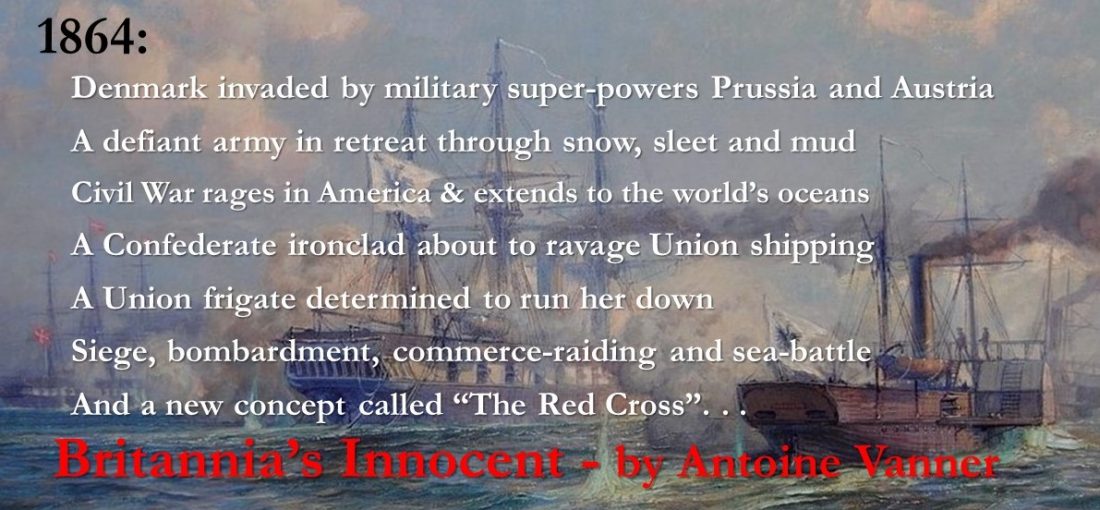The salvage of HMS Royal George, 1782 – 1844
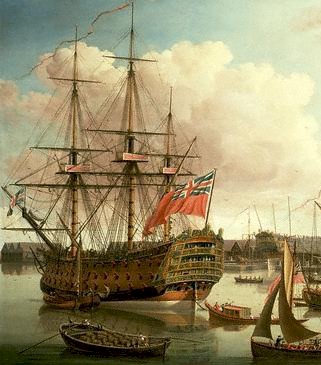
HMS Royal George in her glory
The loss, while at anchor at Spithead, off Portsmouth, of the ship-of-the-line HMS Royal George on August 29th 1782 was a disaster that had an impact on British society comparable to the loss of RMS Titanic one hundred and thirty years later. The catastrophe was described in an earlier article on this site (click here to read it if you missed it then). The sinking was not however the end of the story and the salvage of HMS Royal George, which was to be completed six decades later, was to be an epic in itself and to make innovative use of new diving technology.
Lying as she was in only sixty-five feet of water, in the middle of a busy anchorage and the approaches to Britain’s largest naval base, this enormous vessel, largely intact, represented a major hazard. The sinking had been witnessed by a surgeon on an East Indiaman, Thomas Spalding, whose brother, Charles Spalding (1738 – 1783) already had experience of using diving bells for salvage operations.
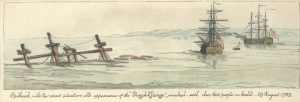
HMS Royal George in the aftermath of her sinking,
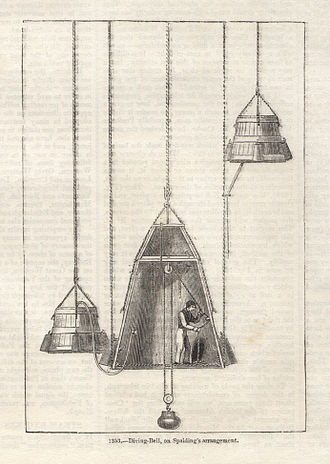 Charles Spalding’s Bell – the two smaller bells seemed to have been used for bringing fresh air supplies to the main bell. Note tube running to it from the small bell on the left
Charles Spalding’s Bell – the two smaller bells seemed to have been used for bringing fresh air supplies to the main bell. Note tube running to it from the small bell on the left
Innovative and courageous, Charles originally a confectioner with a shop in Edinburgh, had made significant safety and operational improvements to existing bell designs. Large enough to accommodate two men, and with glass windows to provide light, Spalding’s bell was lowered by a counterweight system – which allowed fast recovery – and had a rope-based signalling system. Thomas Spalding immediately saw that the wreck of HMS Royal George could be an opportunity for his brother. He therefore suggested to the Admiralty that they could recover valuable stores and weapons from her wreck.
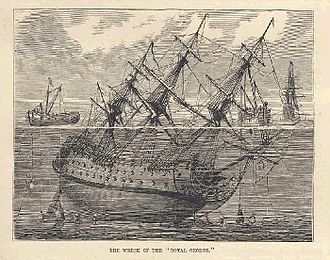 Work in progress by the Spaldings – note bells, for which working on the hull was difficult
Work in progress by the Spaldings – note bells, for which working on the hull was difficult
Having gained agreement, the Spaldings got to work quickly. In little over a month – most of October and early November – and despite poor weather, they managed to raise fifteen guns, for which the Admiralty paid £400. It is remarkable that the Spaldings achieved as much as they did – the bell was unsuitable for working on a large object that rose well clear of the seabed. (see illustration) There does however appear to have been a substantial amount of debris on the ground – it is easy to imagine heavy items like cannon breaking free as HMS Royal George heeled over. The Spaldings might have returned to the work after the winter had another, and potentially a more lucrative, opportunity arise. This was the sinking of the East-Indiaman Count de Belgioso on the Kish Bank, outside Dublin. She had been carrying silver and lead – salvage of even a part would have been vastly profitable. In the event the effort proved disastrous – in June 1783 Charles Spalding and a worker with him died in the bell and operations ceased.
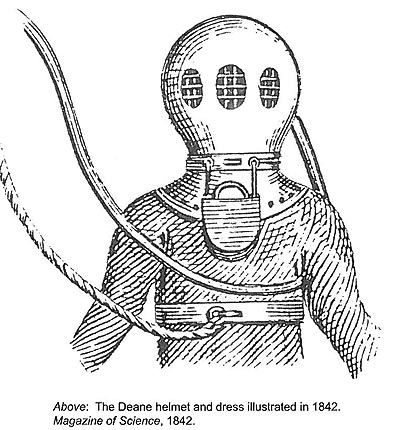
Deane helmet, 1842
The next attempt at salvage had to wait until 1834. By then the first and rudimentary first air-pumped diving helmets had become available, invented by the brothers Deane, Charles Anthony (1796-1848) and John (1800 – 1884). For them too, the Royal George wreck represented an opportunity. By this time the hull had partly disintegrated, making it possible to recover more from the debris. The brothers worked for two years, 1834-36, recovering a total of twenty-eight guns. It proved impossible to reach any more as they were buried beneath mud and shattered hull-timbers. It was during this time that the Deans were asked by local fishermen to investigate another wreck close by that was damaging their nets. The brothers did so and thereby located the Mary Rose, Henry VIII’s flagship that had been lost in 1545. (Sections of the Mary Rose’s hull are on display today at the Portsmouth dockyard).

Sir Charles Pasley
The final, and most complete, salvage effort came in 1839 and was to last until 1844. The work was entrusted to the army’s Corps of Royal Engineers under the direction of Colonel (and later General) Charles Pasley (1780-1861). He was systematic, thorough and persistent. Basing his plans on previous demolition of wrecks in the Thames estuary by explosive charges, he determined to blast the remained of HMS Royal George’s hull apart, step by step, and pick up the resulting debris. He had the advantage of air-pumped diving helmets – as developed by the Deanes – as well as having a team of disciplined men as divers. Significant technical progress was also made in underwater blasting. The initial approach was to use gunpowder packed in wooden barrels and sheathed with lead, the detonators being chemical fuses. Given the uncertainty as to how long such detonators would take to explode, placing these charges must have been nerve-racking. Copper cylinders were used later, with electrically-triggered detonation. This allowed a number of such charges to be placed around the wreck and detonated simultaneously from a distance. The largest of the explosions, in 1840, that which finally smashed the remainder of the hull to fragments, was powerful enough to shatter windows in nearby Portsmouth. A total of thirty cannon were recovered, as well as other ironwork, but the chief objective was the removal of the debris as a shipping hazard. An account written in 1877 indicated that the divers were frequently “six to eight hours a day underwater” – if true, it was appalling labour. It was noted that “by long experience they had come to economise time and effort in so skilful a manner, that all of them sent up to the boats in attendance on them their bundles of staves, casks or timber as closely packed together as a woodman would make up his faggots in the open air.”
When Pasley’s team finished work in 1844, the seabed was at last clear of the remains of HMS Royal George, a ship that had proudly flown the flag of Admiral Lord Hawke at the Battle of Quiberon Bay in 1759. Sic transit…
Britannia’s Innocent: The first chronologically of the Dawlish Chronicles Series:
Typical 5-star review on Amazon, named “The most thoughtful Naval adventure series, ever.“
“Each of the Dawlish Chronicles is better than the last. Combines the action and adventure of Tom Clancy or Bernard Cornwell, with the sensibility of Henry James or Jack London. The hero perseveres in the face of adversity and remains true to his principles and evolving moral sensibilities: becoming more complete with each challenge. Not jingoistic, but a determined ethical man, who will fulfil his duty to the ends of the earth. I can’t wait for the next novel in this series! Thank you Mr Vanner for this fabulous hero placed so aptly into a backdrop of eminent Victorians.”
For more details, click below:
For amazon.com For amazon.co.uk For amazon.com.au
As with all Dawlish Chronicles novels, Kindle Unlimited subscribers can read it at no extra cost.
The Dawlish Chronicles – now up to ten volumes, and counting. Click on the banner above for more details
Six free short stories are available for download to your Kindle. Access them by registering for the Dawlish Chronicles mailing list – just click on the banner below. You’ll be kept updated on new books and will receive other free stories at intervals.


